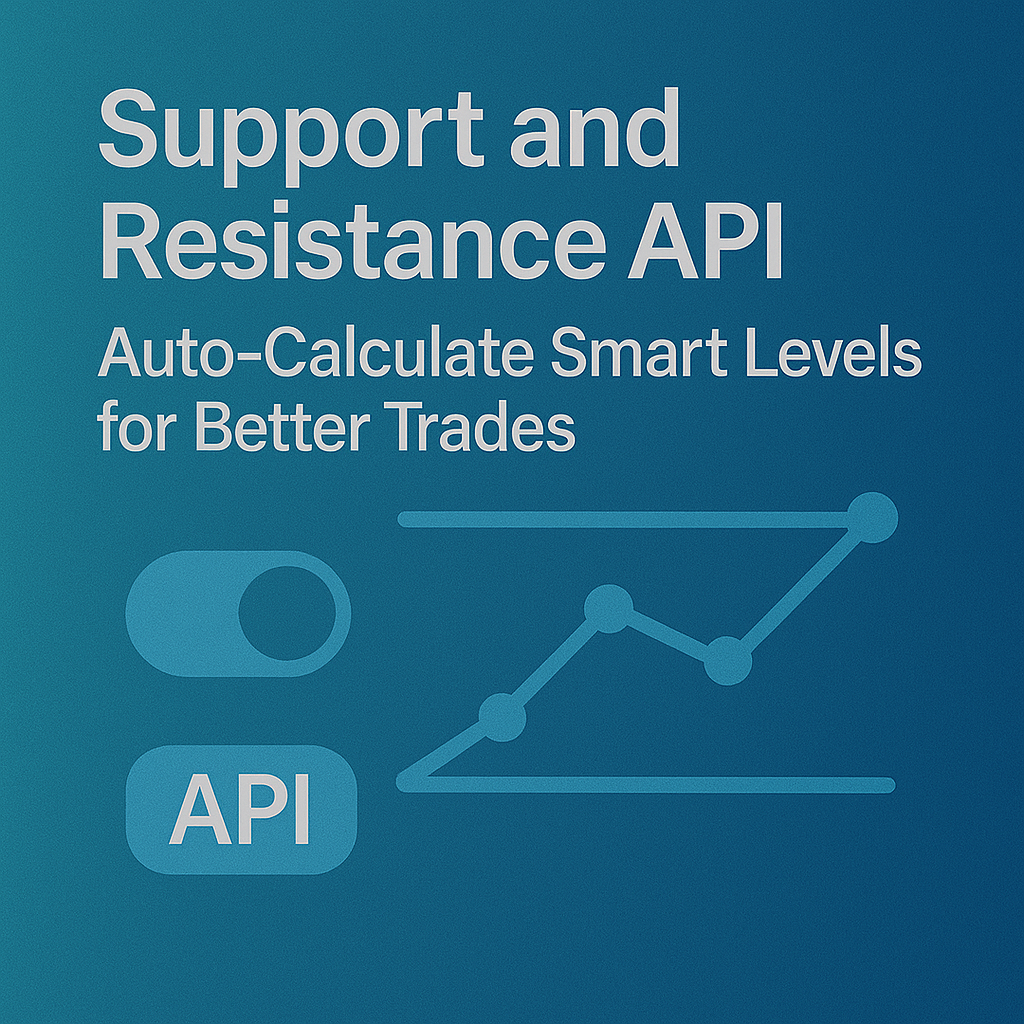Top Crypto Trading Platforms in 2025







%201.svg)
%201.svg)
Big news: We’re cranking up the heat on AI-driven crypto analytics with the launch of the Token Metrics API and our official SDK (Software Development Kit). This isn’t just an upgrade – it's a quantum leap, giving traders, hedge funds, developers, and institutions direct access to cutting-edge market intelligence, trading signals, and predictive analytics.
Crypto markets move fast, and having real-time, AI-powered insights can be the difference between catching the next big trend or getting left behind. Until now, traders and quants have been wrestling with scattered data, delayed reporting, and a lack of truly predictive analytics. Not anymore.
The Token Metrics API delivers 32+ high-performance endpoints packed with powerful AI-driven insights right into your lap, including:
Getting started with the Token Metrics API is simple:
At Token Metrics, we believe data should be decentralized, predictive, and actionable.
The Token Metrics API & SDK bring next-gen AI-powered crypto intelligence to anyone looking to trade smarter, build better, and stay ahead of the curve. With our official SDK, developers can plug these insights into their own trading bots, dashboards, and research tools – no need to reinvent the wheel.
%201.svg)
%201.svg)
The biggest gains in crypto rarely come from the majors. They come from Moonshots—fast-moving tokens with breakout potential. The Moonshots API surfaces these candidates programmatically so you can rank, alert, and act inside your product. In this guide, you’ll call /v2/moonshots, display a high-signal list with TM Grade and Bullish tags, and wire it into bots, dashboards, or screeners in minutes. Start by grabbing your key at Get API Key, then Run Hello-TM and Clone a Template to ship fast.

Discovery that converts. Users want more than price tickers—they want a curated, explainable list of high-potential tokens. The moonshots API encapsulates multiple signals into a short list designed for exploration, alerts, and watchlists you can monetize.
Built for builders. The endpoint returns a consistent schema with grade, signal, and context so you can immediately sort, badge, and trigger workflows. With predictable latency and clear filters, you can scale to dashboards, mobile apps, and headless bots without reinventing the discovery pipeline.
The Moonshots API cURL request is right there in the top right of the API Reference. Grab it and start tapping into the potential!
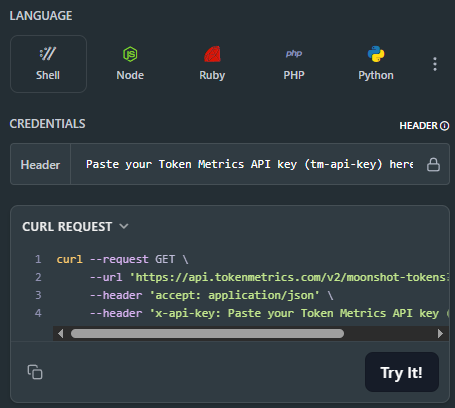
👉 Keep momentum: Get API Key • Run Hello-TM • Clone a Template
Fork a screener or alerting template, plug your key, and deploy. Validate your environment with Hello-TM. When you scale users or need higher limits, compare API plans.
The Moonshots endpoint aggregates a set of evidence—often combining TM Grade, signal state, and momentum/volume context—into a shortlist of breakout candidates. Each row includes a symbol, grade, signal, and timestamp, plus optional reason tags for transparency.
For UX, a common pattern is: headline list → token detail where you render TM Grade (quality), Trading Signals (timing), Support/Resistance (risk placement), Quantmetrics (risk-adjusted performance), and Price Prediction scenarios. This lets users understand why a token was flagged and how to act with risk controls.
Polling vs webhooks. Dashboards typically poll with short-TTL caching. Alerting flows use scheduled jobs or webhooks (where available) to smooth traffic and avoid duplicates. Always make notifications idempotent.
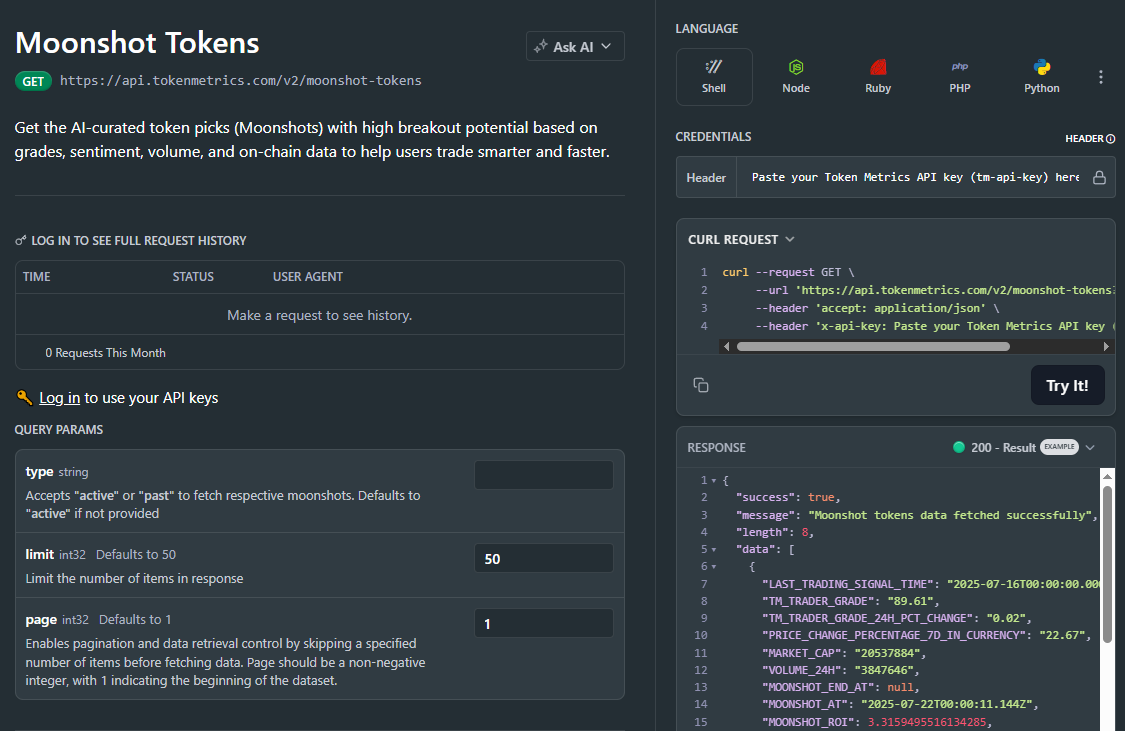
1) What does the Moonshots API return?
A list of breakout candidates with fields such as symbol, tm_grade, signal (often Bullish/Bearish), optional reason tags, and updated_at. Use it to drive discover tabs, alerts, and watchlists.
2) How fresh is the list? What about latency/SLOs?
The endpoint targets predictable latency and timely updates for dashboards and alerts. Use short-TTL caching and queued jobs/webhooks to avoid bursty polling.
3) How do I use Moonshots in a trading workflow?
Common stack: Moonshots for discovery, Trading Signals for timing, Support/Resistance for SL/TP, Quantmetrics for sizing, and Price Prediction for scenario context. Always backtest and paper-trade first.
4) I saw results like “+241%” and a “7.5% average return.” Are these guaranteed?
No. Any historical results are illustrative and not guarantees of future performance. Markets are risky; use risk management and testing.
5) Can I filter the Moonshots list?
Yes—pass parameters like min_grade, signal, and limit (as supported) to tailor to your audience and keep pages fast.
6) Do you provide SDKs or examples?
REST works with JavaScript and Python snippets above. Docs include quickstarts, Postman collections, and templates—start with Run Hello-TM.
7) Pricing, limits, and enterprise SLAs?
Begin free and scale up. See API plans for rate limits and enterprise options.
%201.svg)
%201.svg)
Most traders still draw lines by hand in TradingView. The support and resistance API from Token Metrics auto-calculates clean support and resistance levels from one request, so your dashboard, bot, or alerts can react instantly. In minutes, you’ll call /v2/resistance-support, render actionable levels for any token, and wire them into stops, targets, or notifications. Start by grabbing your key on Get API Key, then Run Hello-TM and Clone a Template to ship a production-ready feature fast.
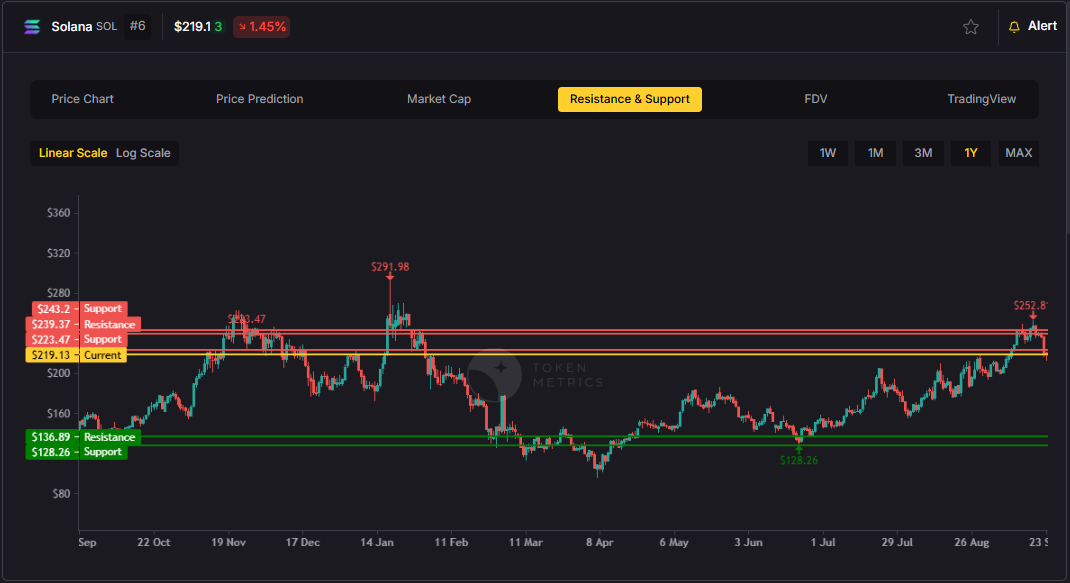
Precision beats guesswork. Hand-drawn lines are subjective and slow. The support and resistance API standardizes levels across assets and timeframes, enabling deterministic stops and take-profits your users (and bots) can trust.
Production-ready by design. A simple REST shape, predictable latency, and clear semantics let you add levels to token pages, automate SL/TP alerts, and build rule-based execution with minimal glue code.
Need the Support and Resistance data? The cURL request for it is in the top right of the API Reference for quick access.

👉 Keep momentum: Get API Key • Run Hello-TM • Clone a Template
Kick off with our quickstarts—fork a bot or dashboard template, plug your key, and deploy. Confirm your environment by Running Hello-TM. When you’re scaling or need webhooks/limits, review API plans.
The Support/Resistance endpoint analyzes recent price structure to produce discrete levels above and below current price, along with strength indicators you can use for priority and styling. Query /v2/resistance-support?symbol=<ASSET>&timeframe=<HORIZON> to receive arrays of level objects and timestamps.
Polling vs webhooks. For dashboards, short-TTL caching and batched fetches keep pages snappy. For bots and alerts, use queued jobs or webhooks (where applicable) to avoid noisy, bursty polling—especially around market opens and major events.
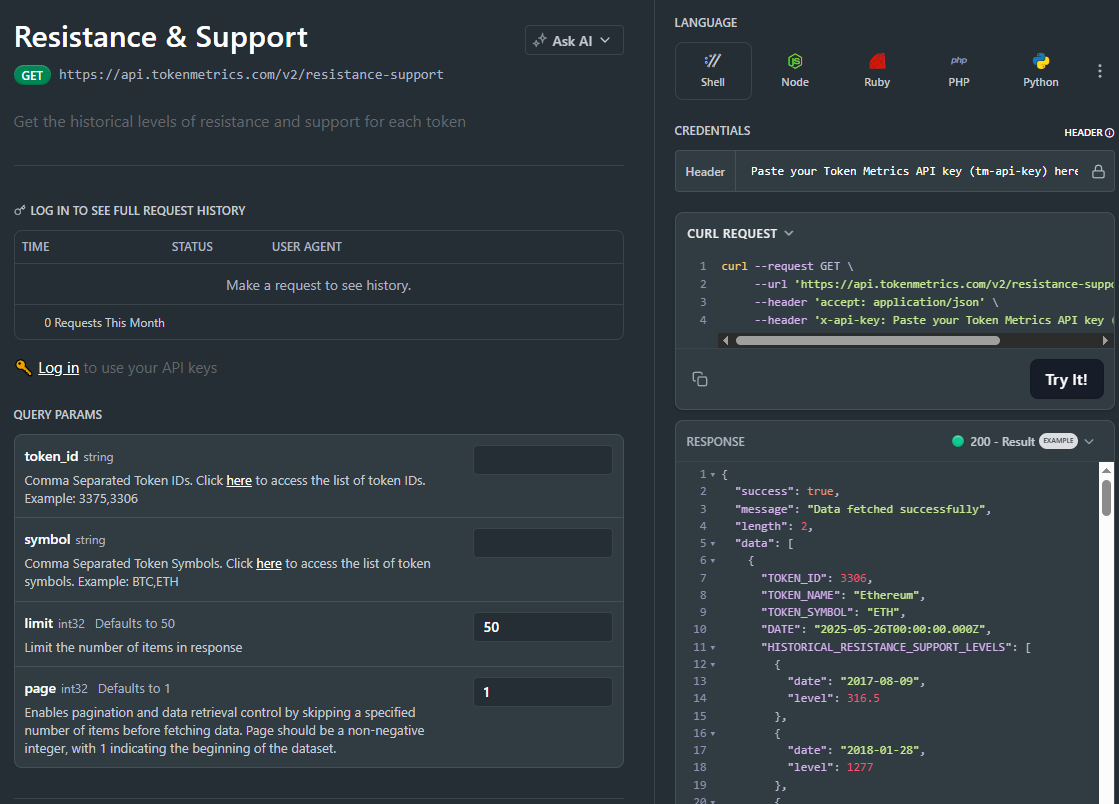
1) What does the Support & Resistance API return?
A JSON payload with arrays of support and resistance levels for a symbol (and optional timeframe), each with a price and strength indicator, plus an update timestamp.
2) How timely are the levels? What are the latency/SLOs?
The endpoint targets predictable latency suitable for dashboards and alerts. Use short-TTL caching for UIs, and queued jobs or webhooks for alerting to smooth traffic.
3) How do I trigger alerts or trades from levels?
Common patterns: alert when price is within X% of a level, touches a level, or breaks beyond with confirmation. Always make downstream actions idempotent and respect rate limits.
4) Can I combine levels with other endpoints?
Yes—pair with /v2/trading-signals for timing, /v2/tm-grade for quality context, and /v2/quantmetrics for risk sizing. This yields a complete decide-plan-execute loop.
5) Which timeframe should I use?
Intraday bots prefer shorter horizons; swing/position dashboards use daily or higher-timeframe levels. Offer a timeframe toggle and cache results per setting.
6) Do you provide SDKs or examples?
Use the REST snippets above (JS/Python). The docs include quickstarts, Postman collections, and templates—start with Run Hello-TM.
7) Pricing, limits, and enterprise SLAs?
Begin free and scale as you grow. See API plans for rate limits and enterprise SLA options.
%201.svg)
%201.svg)
Most traders see price—quants see probabilities. The Quantmetrics API turns raw performance into risk-adjusted stats like Sharpe, Sortino, volatility, drawdown, and CAGR so you can compare tokens objectively and build smarter bots and dashboards. In minutes, you’ll query /v2/quantmetrics, render a clear performance snapshot, and ship a feature that customers trust. Start by grabbing your key at Get API Key, Run Hello-TM to verify your first call, then Clone a Template to go live fast.
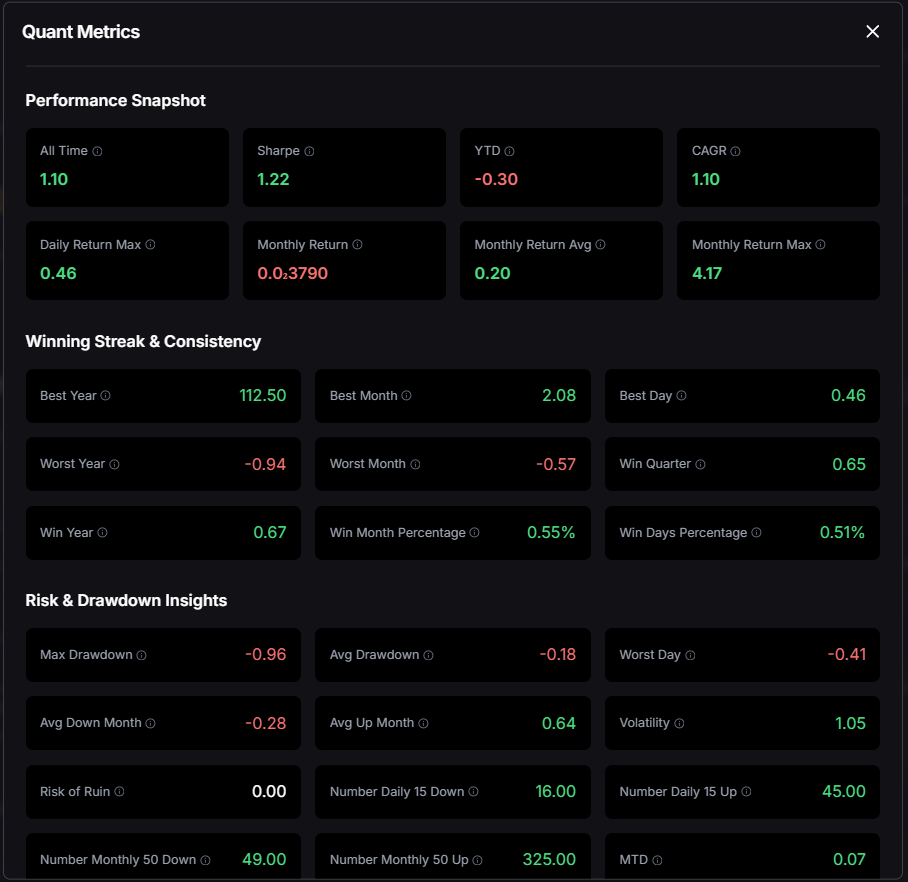
Risk-adjusted truth beats hype. Price alone hides tail risk and whipsaws. Quantmetrics compresses edge, risk, and consistency into metrics that travel across assets and timeframes—so you can rank universes, size positions, and communicate performance like a pro.
Built for dev speed. A clean REST schema, predictable latency, and easy auth mean you can plug Sharpe/Sortino into bots, dashboards, and screeners without maintaining your own analytics pipeline. Pair with caching and batching to serve fast pages at scale.
The Quant Metrics cURL request is located in the top right of the API Reference, allowing you to easily integrate it with your application.
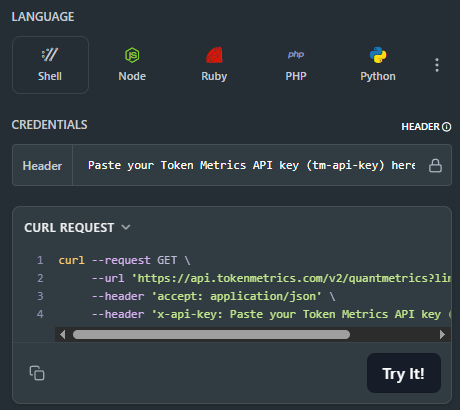
👉 Keep momentum: Get API Key • Run Hello-TM • Clone a Template
Kick off from quickstarts in the docs—fork a dashboard or screener template, plug your key, and deploy in minutes. Validate your environment with Run Hello-TM; when you need more throughput or webhooks, compare API plans.
Quantmetrics computes risk-adjusted performance over a chosen lookback (e.g., 30d, 90d, 1y). You’ll receive a JSON snapshot with core statistics:
Call /v2/quantmetrics?symbol=<ASSET>&window=<LOOKBACK> to fetch the current snapshot. For dashboards spanning many tokens, batch symbols and apply short-TTL caching. If you generate alerts (e.g., “Sharpe crossed 1.5”), run a scheduled job and queue notifications to avoid bursty polling.
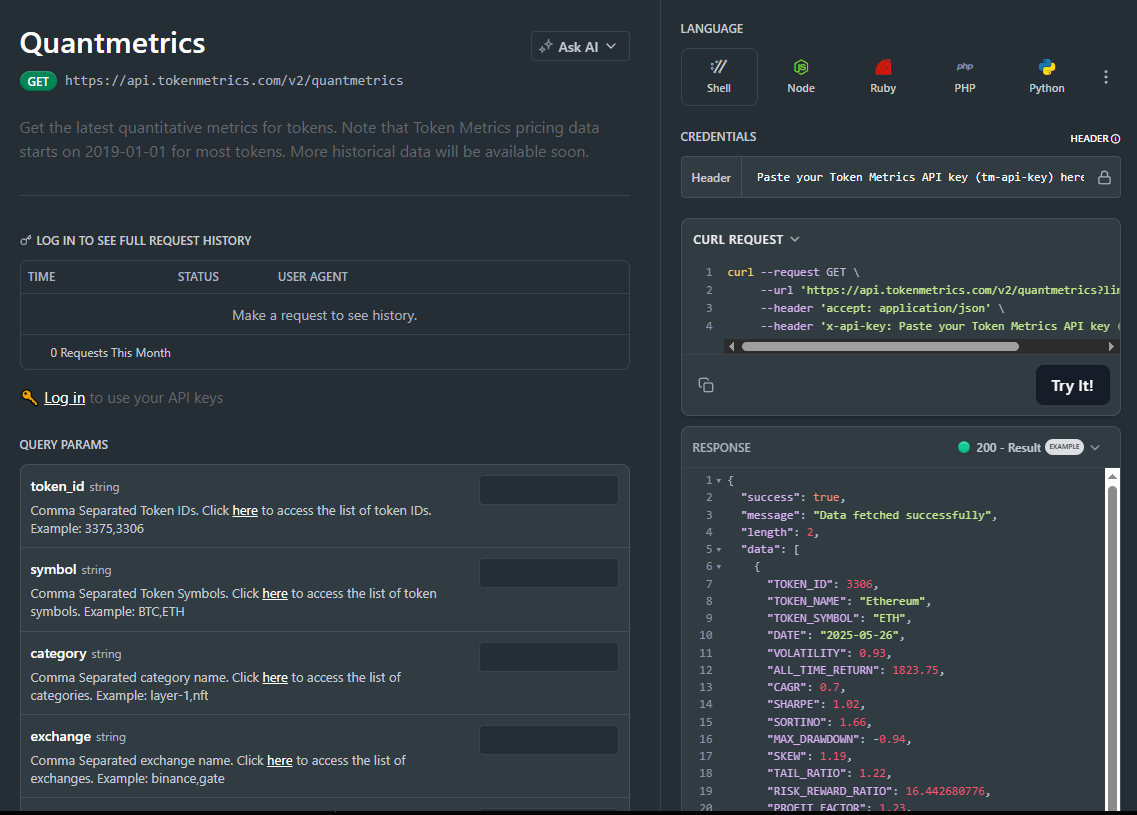
1) What does the Quantmetrics API return?
A JSON snapshot of risk-adjusted metrics (e.g., Sharpe, Sortino, volatility, max drawdown, CAGR) for a symbol and lookback window—ideal for ranking, sizing, and dashboards.
2) How fresh are the stats? What about latency/SLOs?
Responses are engineered for predictable latency. For heavy UI usage, add short-TTL caching and batch requests; for alerts, use scheduled jobs or webhooks where available.
3) Can I use Quantmetrics to size positions in a live bot?
Yes—many quants size inversely to volatility or require Sharpe ≥ X to trade. Always backtest and paper-trade before going live; past results are illustrative, not guarantees.
4) Which lookback window should I choose?
Short windows (30–90d) adapt faster but are noisier; longer windows (6–12m) are steadier but slower to react. Offer users a toggle and cache each window.
5) Do you provide SDKs or examples?
REST is straightforward (JS/Python above). Docs include quickstarts, Postman collections, and templates—start with Run Hello-TM.
6) Polling vs webhooks for quant alerts?
Dashboards usually use cached polling. For threshold alerts (e.g., Sharpe crosses 1.0), run scheduled jobs and queue notifications to keep usage smooth and idempotent.
7) Pricing, limits, and enterprise SLAs?
Begin free and scale up. See API plans for rate limits and enterprise SLA options.

%201.svg)
%201.svg)
REST APIs power much of the modern web: mobile apps, single-page frontends, third-party integrations, and many backend services communicate via RESTful endpoints. This guide breaks down the core principles, design patterns, security considerations, and practical workflows for building and consuming reliable REST APIs. Whether you are evaluating an external API or designing one for production, the frameworks and checklists here will help you ask the right technical questions and set up measurable controls.
REST (Representational State Transfer) is an architectural style for networked applications that uses stateless communication, standard HTTP verbs, and resource-oriented URLs. A REST API exposes resources (users, orders, prices, metadata) as endpoints that clients can retrieve or modify. The simplicity of the model and ubiquity of HTTP make REST a common choice for public APIs and internal microservices.
Key benefits include:
Designing a good REST API starts with consistent use of HTTP semantics. The common verbs and their typical uses are:
Good RESTful design also emphasizes:
Well-documented APIs reduce integration friction and errors. Follow these practical habits:
Automate documentation generation and run contract tests as part of CI to detect regressions early.
Security and observability are essential. Practical controls and patterns include:
Security reviews and occasional red-team exercises help identify gaps beyond static checks.
Consuming and testing REST APIs fits into several common workflows:
When building sector-specific APIs — for example, price feeds or on-chain data — combining REST endpoints with streaming (webhooks or websockets) can deliver both historical queries and low-latency updates. AI-driven analytics platforms can help synthesize large API outputs into actionable signals and summaries; for example, Token Metrics and similar tools can ingest API data for model-driven analysis without manual aggregation.
Build Smarter Crypto Apps & AI Agents with Token Metrics
Token Metrics provides real-time prices, trading signals, and on-chain insights all from one powerful API. Grab a Free API Key
REST describes the architectural constraints and principles. "RESTful" is commonly used to describe APIs that follow those principles, i.e., resource-based design, stateless interactions, and use of standard HTTP verbs.
Expose a clear versioning strategy early. Path versioning (/v1/) is explicit and simple, while header or content negotiation can be more flexible. Regardless of approach, document migration timelines and provide backward compatibility where feasible.
Use PUT to replace a resource fully; use PATCH to apply partial updates. PATCH payloads should be well-defined (JSON Patch or application/merge-patch+json) to avoid ambiguity.
Offset-based pagination is easy to implement but can produce inconsistent results with concurrent writes. Cursor-based (opaque token) pagination is more robust for large, frequently changing datasets.
Use OpenAPI specs combined with contract testing tools that validate servers against the spec. Include integration tests in CI that exercise representative workflows and simulate error conditions and rate limits.
Apply tiered access controls: provide limited free access with API keys and rate limits for discovery, and require stronger auth (OAuth, signed requests) for sensitive endpoints. Clear docs and quickstart SDKs reduce friction for legitimate users.
Track latency percentiles (p50/p95/p99), error rates by status code, request volume, and authentication failures. Correlate these with infrastructure metrics and traces to identify root causes quickly.
Yes. REST APIs can serve as a data ingestion layer for AI workflows, supplying labeled data, telemetry, and features. Combining batch and streaming APIs allows models to access both historical and near-real-time inputs for inference and retraining.
GraphQL offers flexible client-driven queries and can reduce overfetching, while gRPC provides efficient binary RPC for internal services. Choose based on client needs, performance constraints, and team expertise.
Disclaimer
This article is educational and technical in nature. It does not provide investment, legal, or regulatory advice. Implementations and design choices should be validated against your organization’s security policies and compliance requirements.
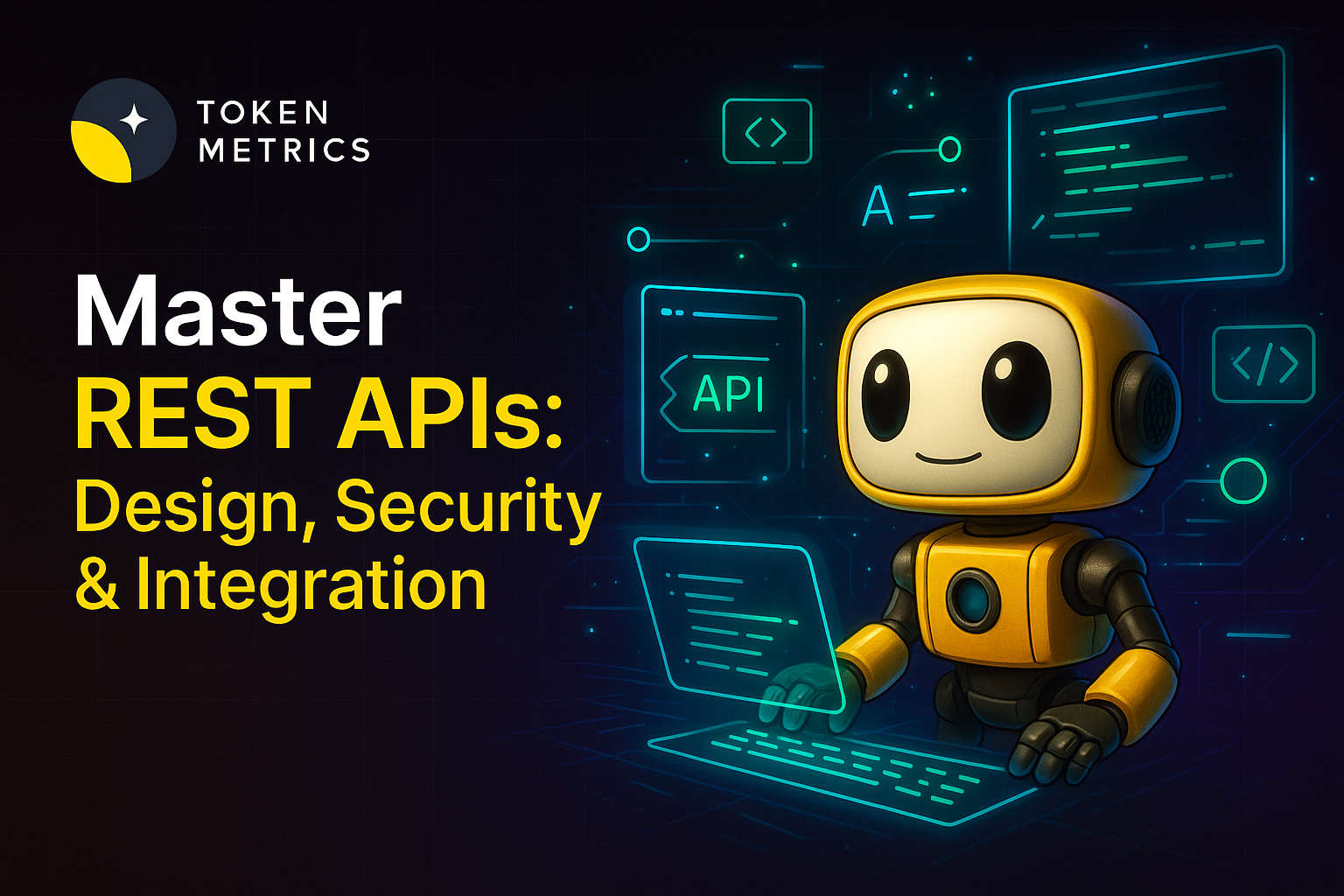
%201.svg)
%201.svg)
REST APIs are the lingua franca of modern web and data ecosystems. Developers, data scientists, and product teams rely on RESTful endpoints to move structured data between services, power mobile apps, and connect AI models to live data sources. This post explains what REST APIs are, the core principles and methods, practical design patterns, security considerations, and how to evaluate REST APIs for use in crypto and AI workflows.
Representational State Transfer (REST) is an architectural style for distributed systems. A REST API exposes resources—such as users, orders, or market ticks—via predictable URLs and HTTP methods. Each resource representation is typically transferred in JSON, XML, or other media types. The API defines endpoints, input and output schemas, and expected status codes so clients can programmatically interact with a server.
Key characteristics include stateless requests, cacheable responses when appropriate, uniform interfaces, and resource-oriented URIs. REST is not a protocol but a set of conventions that favor simplicity, scalability, and composability. These properties make REST APIs well-suited for microservices, web clients, and integrations with analytics or machine learning pipelines.
Understanding the mapping between REST semantics and HTTP verbs is foundational:
Designing clear resource names and predictable query parameters improves developer experience. Use nouns for endpoints (e.g., /api/v1/orders) and separate filtering, sorting, and pagination parameters. Well-structured response envelopes with consistent error codes and time stamps help automation and observability.
Good REST API design balances usability, performance, and security. Start with a contract-first approach: define OpenAPI/Swagger schemas that describe endpoints, request/response shapes, authentication, and error responses. Contracts enable auto-generated clients, mock servers, and validation tooling.
Security considerations include:
Operational best practices include logging structured events, exposing health and metrics endpoints, and versioning APIs (e.g., v1, v2) to enable backward-compatible evolution. Use semantic versioning in client libraries and deprecate endpoints with clear timelines and migration guides.
Testing a REST API includes unit tests for business logic, contract tests against OpenAPI definitions, and end-to-end integration tests. Performance profiling should focus on latency tail behavior, not just averages. Key tools and techniques:
For AI systems, robust APIs must address reproducibility: include schema versioning and event timestamps so models can be retrained with consistent historical data. For crypto-related systems, ensure on-chain data sources and price oracles expose deterministic endpoints and clearly document freshness guarantees.
REST APIs are frequently used to expose market data, on-chain metrics, historical time-series, and signals that feed AI models or dashboards. When integrating third-party APIs for crypto data, evaluate latency, update frequency, and the provider's methodology for derived metrics. Consider fallbacks and reconciliations: multiple independent endpoints can be polled and compared to detect anomalies or outages.
AI agents often consume REST endpoints for feature extraction and live inference. Design APIs with predictable rate limits and batching endpoints to reduce overhead. Document data lineage: indicate when data is fetched, normalized, or transformed so model training and validation remain auditable.
Tools that combine real-time prices, on-chain insights, and signal generation can accelerate prototyping of analytics and agents. For example, Token Metrics provides AI-driven research and analytics that teams can evaluate as part of their data stack when building integrations.
Build Smarter Crypto Apps & AI Agents with Token Metrics
Token Metrics provides real-time prices, trading signals, and on-chain insights all from one powerful API. Grab a Free API Key
REST is an architectural style that leverages HTTP methods and resource-oriented URIs. It differs from RPC and SOAP by emphasizing uniform interfaces, statelessness, and resource representations. GraphQL is query-oriented and allows clients to request specific fields, which can reduce over-fetching but requires different server-side handling.
Use TLS for transport security, strong authentication (OAuth2, API keys, or mTLS), authorization checks on each endpoint, input validation, rate limiting, and monitoring. Consider short-lived tokens and revoke mechanisms for compromised credentials.
Adopt explicit versioning (path segments like /v1/), maintain backward compatibility when possible, and provide clear deprecation notices with migration guides. Use semantic versioning for client libraries and contract-first changes to minimize breaking updates.
Implement rate limits per API key or token, and communicate limits via headers (e.g., X-RateLimit-Remaining). Provide exponential backoff guidance for clients and consider burst allowances for intermittent workloads. Monitor usage patterns to adjust thresholds.
Essential practices include unit and contract tests, integration tests, load tests, structured logging, distributed tracing, and alerting on error rates or latency SLA breaches. Health checks and automated failover strategies improve availability.
This article is for educational and informational purposes only. It does not constitute investment, financial, or legal advice. Evaluate third-party tools and data sources independently and consider compliance requirements relevant to your jurisdiction and project.
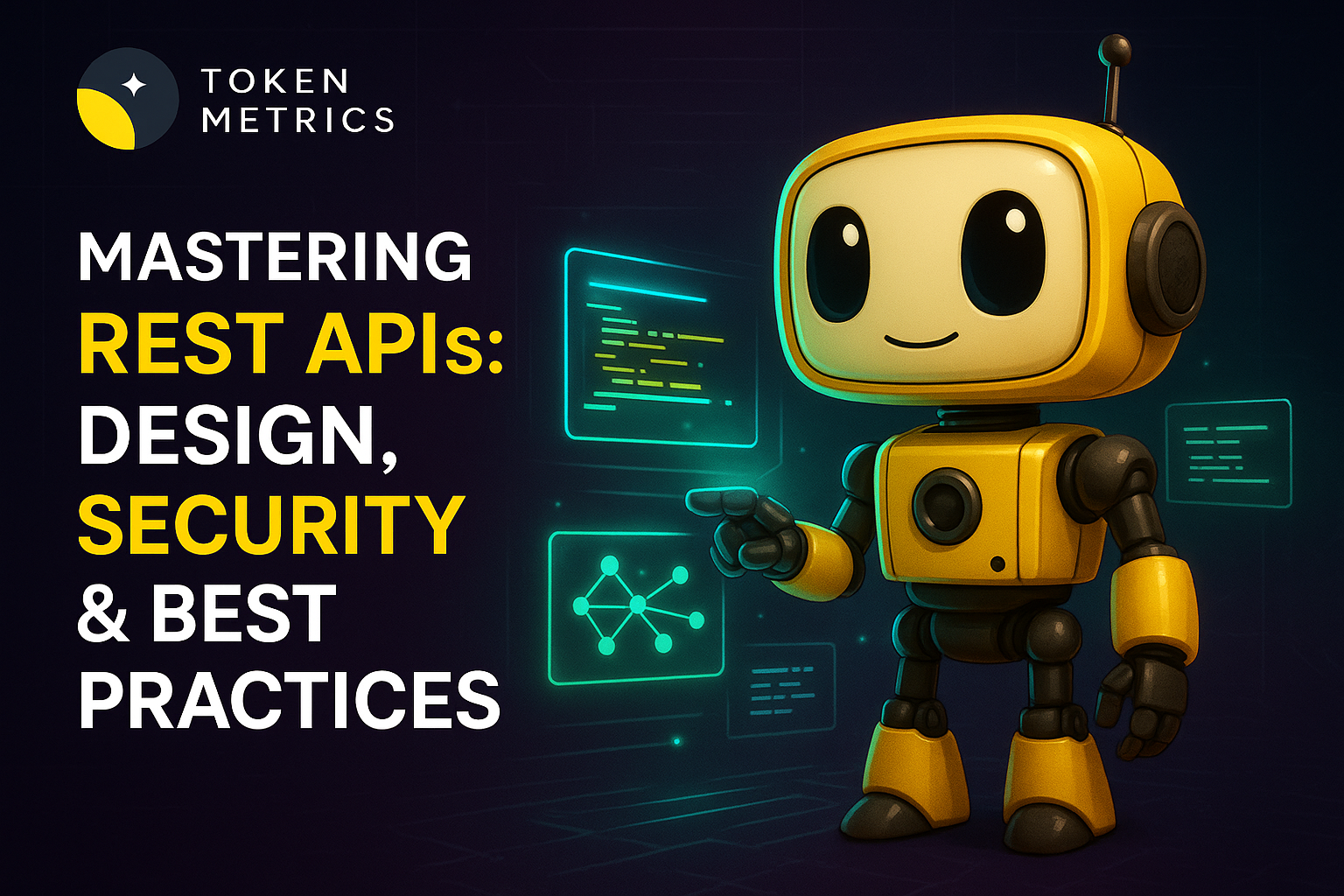
%201.svg)
%201.svg)
REST APIs are the backbone of modern web services and integrations. Whether you are building internal microservices, public developer APIs, or AI-driven data pipelines, understanding REST principles, security models, and performance trade-offs helps you design maintainable and scalable systems.
REST (Representational State Transfer) is an architectural style that relies on stateless communication, uniform interfaces, and resource-oriented design. A REST API exposes resources—users, orders, metrics—via HTTP methods like GET, POST, PUT, PATCH, and DELETE. The simplicity of HTTP, combined with predictable URIs and standard response codes, makes REST APIs easy to adopt across languages and platforms. For teams focused on reliability and clear contracts, REST remains a pragmatic choice, especially when caching, intermediaries, and standard HTTP semantics are important.
Good REST design balances clarity, consistency, and flexibility. Key principles include:
Documenting these conventions—preferably with an OpenAPI/Swagger specification—reduces onboarding friction and supports automated client generation.
Security is non-negotiable. REST APIs commonly use bearer tokens (OAuth 2.0 style) or API keys for authentication, combined with TLS to protect data in transit. Important practices include:
For teams integrating sensitive data or financial endpoints, combining OAuth scopes, robust logging, and policy-driven access control improves operational security while keeping interfaces developer-friendly.
APIs must scale with usage. Optimize for common access patterns and reduce latency through caching, compression, and smart data modeling:
Design decisions should be driven by usage data: measure slow endpoints, understand paginated access patterns, and iterate on the API surface rather than prematurely optimizing obscure cases.
Test automation and telemetry are critical for API resilience. Build a testing pyramid with unit tests for handlers, integration tests for full request/response cycles, and contract tests against your OpenAPI specification. Observability—structured logs, request tracing, and metrics—helps diagnose production issues quickly.
AI-driven tools can accelerate design reviews and anomaly detection. For example, platforms that combine market and on-chain data with AI can ingest REST endpoints and provide signal enrichment or alerting for unusual patterns. When referencing such tools, ensure you evaluate their data sources, explainability, and privacy policies. See Token Metrics for an example of an AI-powered analytics platform used to surface insights from complex datasets.
Build Smarter Crypto Apps & AI Agents with Token Metrics
Token Metrics provides real-time prices, trading signals, and on-chain insights all from one powerful API. Grab a Free API Key
A REST API is an interface that exposes resources over HTTP using stateless requests and standardized methods. It emphasizes a uniform interface, predictable URIs, and leveraging HTTP semantics for behavior and error handling.
REST suits predictable, cacheable endpoints and simple request/response semantics. GraphQL can reduce over-fetching and allow flexible queries from clients. Consider developer experience, caching needs, and operational complexity when choosing between them.
Common approaches include URI versioning (e.g., /v1/) or header-based versioning. The key is to commit to a clear deprecation policy, document breaking changes, and provide migration paths for clients.
Use TLS for all traffic, issue scoped short-lived tokens, validate and sanitize inputs, impose rate limits, and log authentication events. Regular security reviews and dependency updates reduce exposure to known vulnerabilities.
OpenAPI/Swagger, Postman, and contract-testing frameworks allow automated validations. Observability stacks (Prometheus, Jaeger) and synthetic test suites help catch regressions and performance regressions early.
Disclaimer
This article is for educational and technical guidance only. It does not provide financial, legal, or investment advice. Evaluate tools, platforms, and architectural choices based on your organization’s requirements and compliance constraints.
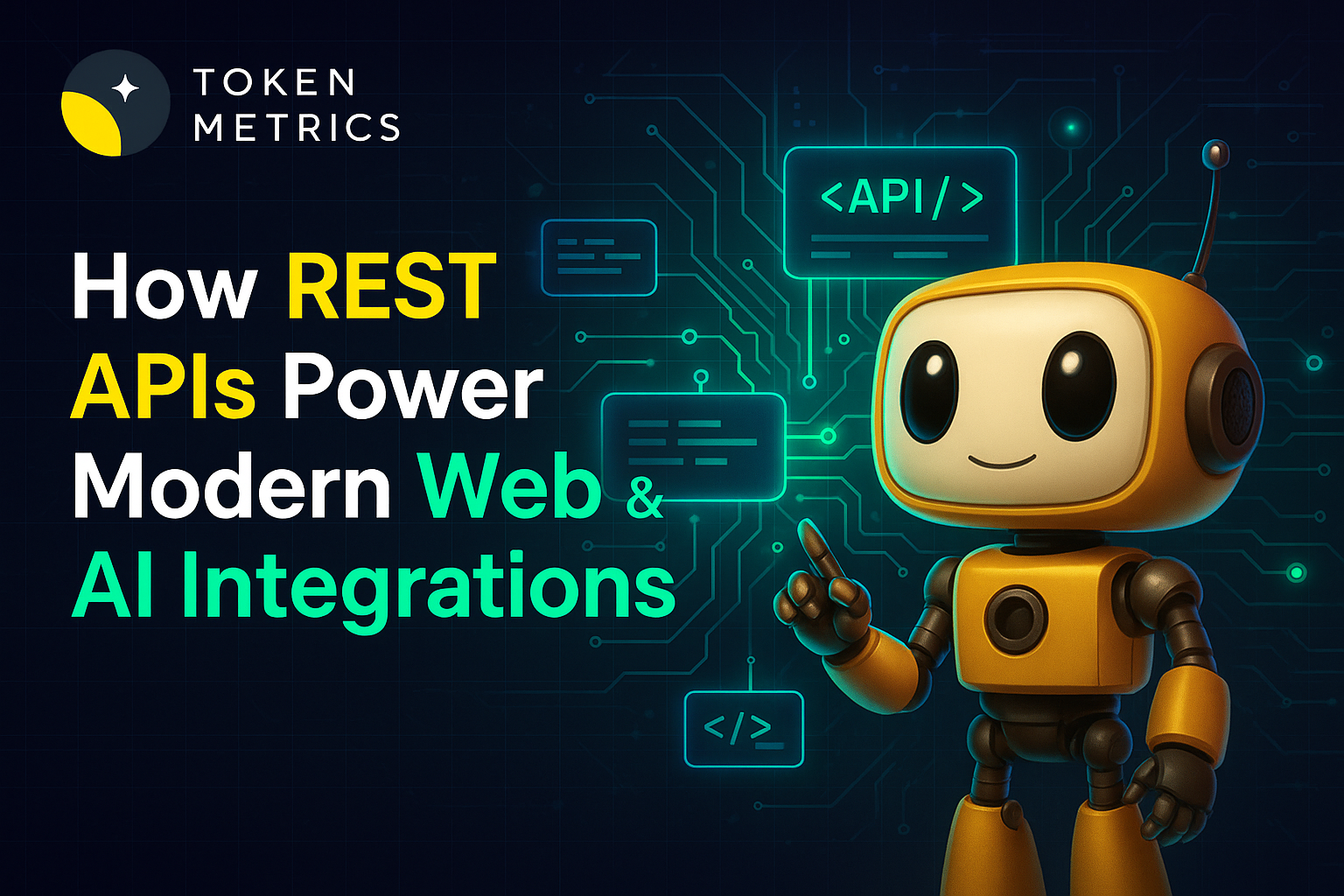
%201.svg)
%201.svg)
REST API technology underpins much of today’s web, mobile, and AI-driven systems. Understanding REST fundamentals, design trade-offs, and operational patterns helps engineers build reliable integrations that scale, remain secure, and are easy to evolve. This article breaks down the core concepts, practical design patterns, and concrete steps to integrate REST APIs with AI and data platforms.
REST (Representational State Transfer) is an architectural style for distributed systems that uses standard HTTP methods to operate on resources. A REST API exposes resources—such as users, orders, or sensor readings—via predictable endpoints and leverages verbs like GET, POST, PUT, PATCH, and DELETE. Key characteristics include statelessness, resource-based URIs, and standardized status codes. These conventions make REST APIs easy to consume across languages, frameworks, and platforms.
Good REST API design balances clarity, stability, and flexibility. Consider these practical principles:
Document endpoints using OpenAPI/Swagger and provide sample requests/responses. Clear documentation reduces integration time and surface area for errors.
Security and observability are central to resilient APIs. Common patterns include:
Operational readiness often separates reliable APIs from fragile ones. Integrate logging and alerting into deployment pipelines and validate SLAs with synthetic checks.
APIs should be treated as products with release processes and compatibility guarantees. Recommended practices:
Following a disciplined lifecycle reduces friction for integrators and supports long-term maintainability.
REST APIs serve as the connective tissue between data sources and AI/analytics systems. Patterns to consider:
AI-driven research platforms and data providers expose REST APIs to make on-chain, market, and derived signals available to models. For example, AI-driven research tools such as Token Metrics provide structured outputs that can be integrated into feature stores and experimentation platforms.
Build Smarter Crypto Apps & AI Agents with Token Metrics
Token Metrics provides real-time prices, trading signals, and on-chain insights all from one powerful API. Grab a Free API Key
REST is an architectural style that uses HTTP and resource-oriented design. Alternatives include RPC-style APIs, GraphQL (which offers a single flexible query endpoint), and gRPC (binary, high-performance RPC). Choose based on latency, schema needs, and client diversity.
Use token-based authentication (OAuth2 client credentials or API keys), enforce TLS, implement scopes or claims to limit access, and rotate credentials periodically. Apply input validation, rate limits, and monitoring to detect misuse.
Version when making breaking changes to request/response contracts. Prefer semantic versioning and provide both current and deprecated versions in parallel during transition windows to minimize client disruption.
OpenAPI/Swagger for documentation, Postman for manual testing, Pact for contract testing, and CI plugins for schema validation and request/response snapshots are common. Automated tests should cover happy and edge cases.
Use tiered limits with burst capacity, return informative headers (remaining/quota/reset), and provide fallback behavior (cached responses or graceful degradation). Communicate limits in documentation so integrators can design around them.
The information in this article is educational and technical in nature. It is not professional, legal, or financial advice. Readers should perform their own due diligence when implementing systems and choosing vendors.

%201.svg)
%201.svg)
REST APIs power modern web and mobile applications by providing a consistent, scalable way to exchange data. Whether you are integrating microservices, powering single-page apps, or exposing data for third-party developers, understanding REST architecture, design norms, and operational considerations is essential to build reliable services.
Representational State Transfer (REST) is an architectural style that leverages standard HTTP methods to manipulate resources represented as URLs. A REST API typically exposes endpoints that return structured data (commonly JSON) and uses verbs like GET, POST, PUT/PATCH, and DELETE to indicate intent. REST is not a protocol; it is a set of constraints—statelessness, uniform interface, and resource-based modeling—that make APIs predictable and cache-friendly.
When evaluating whether to build a REST API, consider use cases: straightforward CRUD operations, broad client compatibility, and caching benefit from REST. If you need strong typing, real-time streaming, or more efficient batching, compare REST to alternatives like GraphQL, gRPC, or WebSockets before deciding.
Good API design starts with resource modeling and clear, consistent conventions. Practical guidelines include:
These conventions improve discoverability and reduce integration friction for third-party developers and internal teams alike.
Security is a primary operational concern. REST APIs must protect data in transit and enforce access controls. Key controls include:
For teams integrating crypto or blockchain data, AI-driven research platforms can automate risk scanning and anomaly detection. For example, Token Metrics provides analytical signals that teams can cross-reference with on-chain activity when modeling API access patterns.
Operational resilience depends on performance engineering and testing. Practical steps include:
Adopt a measurable SLA approach and define clear error budgets to balance feature velocity and reliability.
Build Smarter Crypto Apps & AI Agents with Token Metrics
Token Metrics provides real-time prices, trading signals, and on-chain insights all from one powerful API. Grab a Free API Key
A REST API is an application programming interface that follows REST constraints. It exposes resources via URIs and uses HTTP methods to perform operations, typically exchanging JSON payloads.
REST emphasizes multiple endpoints and resource-based modeling, while GraphQL provides a single endpoint that lets clients request precisely the fields they need. Choose based on data-fetching patterns, caching needs, and client complexity.
Common methods include OAuth 2.0 for delegated access, JWTs for stateless token-based auth, and API keys for service-to-service calls. Use short-lived tokens and secure storage practices to reduce exposure.
Versioning strategies include URI versioning (/v1/resource), header-based negotiation, or semantic compatibility practices. Aim to minimize breaking changes and provide migration guides for clients.
Combine unit tests, integration tests, contract tests (e.g., using OpenAPI), and end-to-end tests. Include load and chaos testing to validate behavior under stress and partial failures.
Implement retries with exponential backoff, set sensible timeouts, use circuit breakers, and degrade gracefully. Observability (tracing and metrics) is essential to detect and respond to issues quickly.
This article is for educational purposes and technical guidance only. It does not constitute investment advice, recommendations, or endorsements. Evaluate tools and services independently, and follow organizational security and compliance policies when designing and deploying APIs.
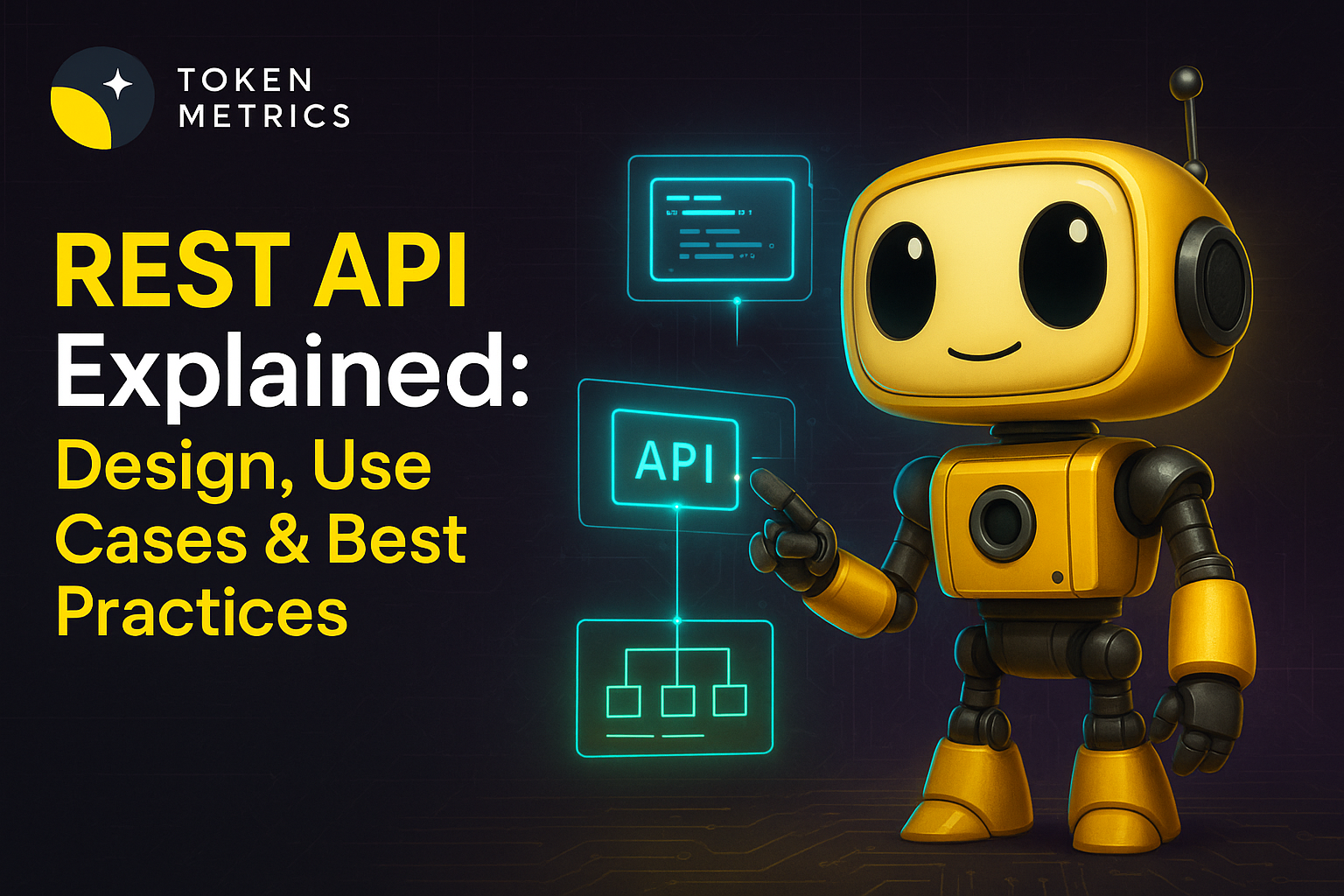
%201.svg)
%201.svg)
REST APIs are the backbone of modern web and mobile integrations. This guide breaks down core concepts, practical design patterns, and operational practices so engineers and product teams can evaluate, build, and maintain resilient RESTful services.
Representational State Transfer (REST) is an architectural style for distributed systems. A REST API exposes resources—typically represented as JSON or XML—over HTTP using standard verbs such as GET, POST, PUT, PATCH, and DELETE. The simplicity and ubiquity of REST make it a go-to choice for connecting microservices, mobile apps, and third-party integrations.
When assessing a REST API, focus on clarity of resource modeling, consistency of endpoints, and predictable use of HTTP semantics. Well-designed REST APIs reduce onboarding friction, simplify client code, and enable easier testing and monitoring across a heterogeneous environment.
Apply a few core principles to make a REST API robust and maintainable:
Pattern-based approaches—such as HATEOAS (hypermedia links), idempotent write operations, and resource representations optimized for client needs—help balance flexibility with performance. Choose patterns that align with your ecosystem and developer experience goals.
Security and reliability are non-negotiable. Common authentication options include API keys, OAuth 2.0 bearer tokens, and mutual TLS for service-to-service communication. For public APIs, use scopes and granular permissions.
Rate limiting and throttling protect backend systems from spikes and can be implemented at API gateway or service mesh layers. Communicate limits via headers (e.g., X-RateLimit-Remaining) and return 429 responses with retry guidance.
Error handling should be consistent and machine-readable. A common pattern is a top-level error object with code, message, and optionally a trace or documentation URL. For example:
REST APIs are used across many scenarios. Typical patterns include:
When integrating third-party REST APIs, perform a compatibility audit: authentication model, rate limits, data formats, error semantics, and SLA expectations. Automated contract tests (e.g., Pact) and API specifications (OpenAPI/Swagger) reduce integration risk and speed up CI/CD pipelines.
Operational maturity for REST APIs comes from layered testing and observability:
Expose health checks (liveness, readiness) and use alerting thresholds anchored to business metrics (e.g., error budget, p95 latency). Observability data enables root-cause analysis and informs capacity planning.
Build Smarter Crypto Apps & AI Agents with Token Metrics
Token Metrics provides real-time prices, trading signals, and on-chain insights all from one powerful API. Grab a Free API Key
REST is an architectural style emphasizing resources exposed over HTTP with stateless interactions and use of standard verbs. It differs from RPC (remote procedure call) in its resource orientation and from GraphQL in its single-endpoint query flexibility versus REST's multiple resource-oriented endpoints.
Common strategies include URI versioning (/v1/) and header-based versioning. URI versioning is explicit and simpler for clients; header-based supports smoother evolution. Choose a strategy early and document migration steps.
Use TLS, enforce authentication/authorization, rotate credentials, implement least privilege, validate inputs to prevent injection, and rate-limit to mitigate abuse. For machine-to-machine traffic, consider mTLS or OAuth 2.0 client credentials flow.
Collect metrics (latency, error rates), logs, and traces. Correlate these with business KPIs and use correlation IDs to trace individual requests. Automated synthetic monitoring can detect endpoint regressions before users are impacted.
Choose REST for simplicity, widespread tooling, and resource-centric models. GraphQL fits use cases where clients need flexible queries and reduced round-trips. gRPC excels at low-latency service-to-service calls with strict typing. Evaluate client needs, network constraints, and ecosystem tooling.
AI tools can accelerate schema design, generate client SDKs, detect anomalous traffic patterns, and prioritize technical debt. Platforms that combine market and on-chain data with API access can help teams prototype integrations and analyze usage patterns—explore platforms like Token Metrics for AI-driven insights relevant to crypto data APIs.
This article is for educational purposes only. It explains technical concepts related to REST APIs and operational best practices. It does not provide investment advice, recommendations, or endorsements. Evaluate tools and architectural choices independently based on your requirements and constraints.
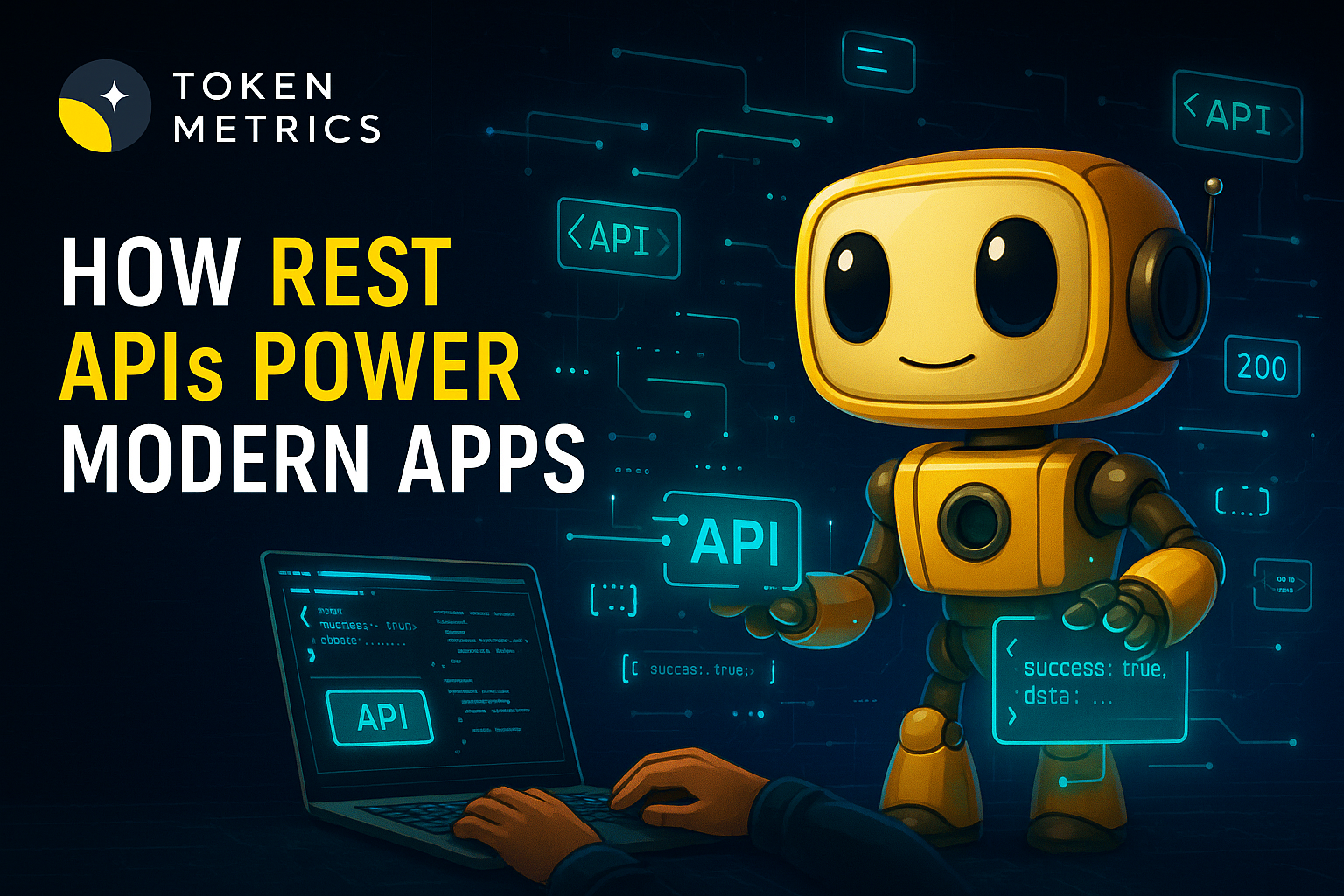
%201.svg)
%201.svg)
APIs are the connective tissue of modern software. Among architectural styles, the REST API remains a dominant approach for exposing resources over HTTP. This article explains what REST APIs are, the principles behind them, practical design patterns, security and testing considerations, and how AI-driven tools can streamline API development and analysis without prescribing decisions.
REST (Representational State Transfer) is an architectural style for distributed systems that emphasizes stateless interactions, resource-oriented URLs, and standard HTTP verbs (GET, POST, PUT, DELETE, etc.). A REST API exposes resources as endpoints that clients can interact with using these verbs and common data formats such as JSON.
REST APIs are well-suited for web and mobile backends, microservices communication, and public developer platforms because they leverage ubiquitous HTTP tooling and are language-agnostic. They are not a one-size-fits-all: scenarios with complex subscriptions, real-time streaming, or highly stateful workflows may benefit from complementary technologies (e.g., WebSockets, gRPC, GraphQL).
Understanding core REST principles helps teams design predictable, maintainable interfaces. Key concepts include:
Architectural patterns to consider:
Practical design choices reduce friction for integrators and improve operational reliability. Consider these tactics:
Security-related best practices include enforcing TLS, validating inputs, and applying the principle of least privilege for resource access. Authentication options commonly used are API keys, OAuth 2.0, and JWTs; select an approach aligned with threat models and compliance needs.
Robust testing and observability are essential for reliable REST APIs. Typical testing layers include unit tests for business logic, integration tests for endpoints, and contract tests against OpenAPI specifications. Synthetic monitoring and instrumentation (tracing, metrics, structured logs) surface latency trends, error spikes, and usage patterns.
AI-driven tools and analytics can accelerate development and maintenance without replacing human judgment. Use cases include:
When integrating AI tools, validate outputs and maintain clear governance: model suggestions should be reviewed, and generated specs must be tested against realistic scenarios.
Build Smarter Crypto Apps & AI Agents with Token Metrics
Token Metrics provides real-time prices, trading signals, and on-chain insights all from one powerful API. Grab a Free API Key
REST describes the architectural principles; "RESTful" is an adjective applied to services that follow those principles. In practice, developers use the terms interchangeably to describe HTTP-based APIs that model resources and use standard verbs.
Versioning strategies include URI versioning (e.g., /v1/resource), header-based versioning, or content negotiation. Choose a consistent approach and document migration paths. Semantic versioning for the API spec and clear deprecation schedules help clients adapt.
Selection depends on use case: API keys are simple for server-to-server calls; OAuth 2.0 provides delegated access for user-centric flows; JWTs enable stateless session tokens. Evaluate threat models, token lifecycle, and revocation needs before choosing.
Introduce retries with exponential backoff, circuit breakers, idempotency keys for write operations, and graceful degradation on dependent service failures. Also, ensure comprehensive monitoring and alerting so operators can react to incidents swiftly.
OpenAPI/Swagger is the de facto standard for API contracts and interactive docs. Postman and Insomnia are popular for exploratory testing; CI-driven contract tests and integration test suites validate expected behavior. Use static analysis and linting (e.g., Spectral) to enforce consistency.
Rate limits protect backend resources and ensure fair usage. Design endpoints so that expensive operations are clearly documented, offer bulk or async endpoints for heavy workloads, and provide clear limit headers so clients can adapt request rates.
Disclaimer: This article is for educational and technical guidance only. It does not provide financial, legal, or investment advice. Implementations should be validated against project requirements, security standards, and applicable regulations.

%201.svg)
%201.svg)
REST APIs power much of the web and modern applications by providing a simple, scalable contract between clients and servers. Whether you're building microservices, mobile backends, or integrations, understanding REST principles, security trade-offs, and operational practices helps you design reliable interfaces that scale. This guide walks through core concepts, design patterns, security essentials, and practical steps to evaluate and implement REST APIs effectively.
REST (Representational State Transfer) is an architectural style for distributed systems. Rather than a strict protocol, REST prescribes patterns: stateless interactions, resource-oriented URIs, and use of standard HTTP methods (GET, POST, PUT, DELETE, PATCH). The result is a predictable API surface that is easy to cache, route, and evolve.
Key benefits include:
Good REST design balances simplicity, clarity, and forward compatibility. Use the following framework when designing endpoints and contracts:
Document expected request/response schemas and examples. Tools like OpenAPI (Swagger) make it easier to generate client libraries and validate contracts.
Security is a non-functional requirement that must be addressed from day one. Common authentication and authorization patterns include:
Practical security measures:
APIs must be reliable in production. Build a test matrix that covers unit tests, contract tests, and end-to-end scenarios. Useful practices include:
Operationally, design for graceful degradation: return useful error payloads, implement retries with exponential backoff on clients, and provide clear SLAs. AI-driven research and API analytics can help prioritize which endpoints to optimize; for example, Token Metrics illustrates how product data combined with analytics surfaces high-impact areas for improvement.
Build Smarter Crypto Apps & AI Agents with Token Metrics
Token Metrics provides real-time prices, trading signals, and on-chain insights all from one powerful API. Grab a Free API Key
REST stands for Representational State Transfer. It describes a set of constraints—stateless interactions, resource-oriented URIs, and uniform interfaces—rather than a wire protocol. Implementations typically use HTTP and JSON.
SOAP is a strict protocol with XML envelopes, formal contracts (WSDL), and built-in features like WS-Security. REST is more flexible and lightweight. GraphQL exposes a single endpoint that allows clients to request specific fields, reducing over-fetching but adding complexity on the server side. Choose based on client needs, tooling, and team expertise.
Common methods include OAuth 2.0 for delegated access, API keys for simple service access, and JWTs for stateless sessions. Each has trade-offs around revocation, token size, and complexity—consider lifecycle and threat models when selecting an approach.
Versioning strategies include path-based (/v1/resource), header-based, or content negotiation. Path-based versioning is the most explicit and easiest for clients. Maintain backward compatibility where possible and provide clear deprecation timelines and migration guides.
OpenAPI (Swagger) for specification and client generation, Postman for exploratory testing, and contract-testing tools like Pact for ensuring compatibility. Load testing tools (k6, JMeter) and observability platforms complete the pipeline for production readiness.
This article is educational and technical in nature. It provides general information about REST API design, security, and operations, not financial, legal, or investment advice. Assess your own requirements and consult appropriate specialists when implementing systems in production.
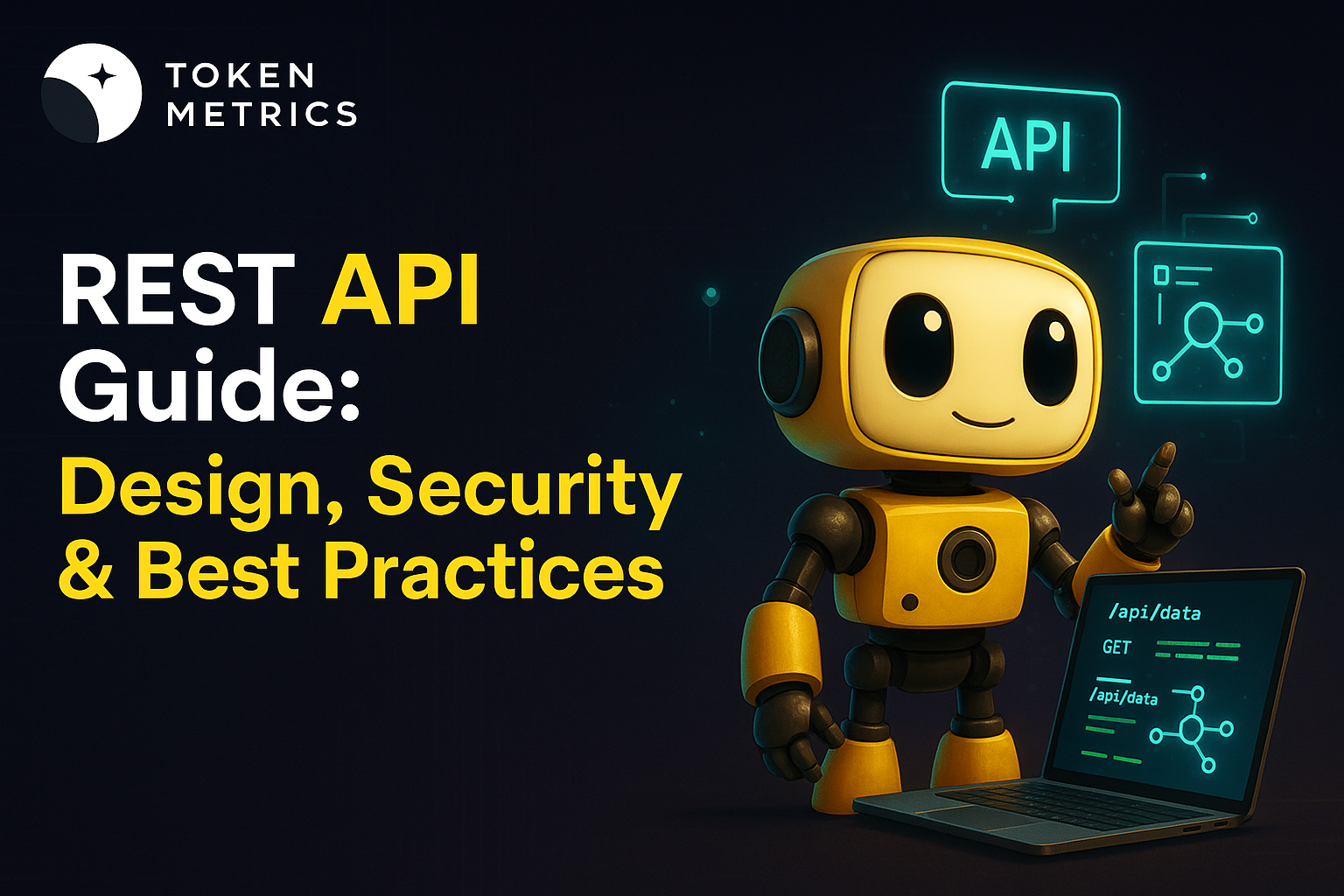
%201.svg)
%201.svg)
REST APIs remain the backbone of modern web and mobile integrations. Whether you are building a public data service, an internal microservice, or an AI agent that consumes remote endpoints, understanding REST architecture, trade-offs, and operational considerations helps you design reliable, maintainable services. This guide outlines core principles, security patterns, performance levers, and practical steps to take a REST API from prototype to production-ready.
REST (Representational State Transfer) is an architectural style that emphasizes stateless interactions, resource-oriented URLs, and a uniform interface over HTTP. REST excels when you need:
It is less ideal for tightly-coupled RPC-style workflows or highly transactional systems where more specialized protocols (gRPC, WebSockets) may be better. Use scenario analysis: list the primary operations, expected throughput, latency requirements, and client types before committing to REST.
Good REST design begins with resource modeling. Convert nouns into endpoints (e.g., /users, /orders/{id}) and use HTTP verbs for actions (GET, POST, PUT, PATCH, DELETE). Key practices include:
Document the contract using OpenAPI/Swagger to enable client generation and automated testing. Maintain a change log and semantic versioning conventions to help consumers plan migrations.
Security must be baked into API design. Core controls include transport security, authentication, authorization, and abuse prevention:
Audit logs and monitoring provide visibility into suspicious patterns. Use a layered approach: perimeter controls, application checks, and runtime protections.
Design for performance from the start. Profile expected workloads and adopt strategies appropriate to scale:
Test performance with realistic load patterns and failure injection. A resilient API recovers gracefully from partial outages and provides useful error information to clients.
Operationalizing a REST API includes client SDKs, developer portals, and automation. Use OpenAPI to generate SDKs in common languages and provide interactive documentation (Swagger UI, Redoc). For AI-driven applications, consider these steps:
AI-driven research and analytics tools can augment API design and monitoring by surfacing anomalies and suggesting schema changes. For example, platforms that combine on-chain and market data help teams design endpoints that better serve analytics workloads—see Token Metrics for an example of an AI-powered crypto research tool that demonstrates how combining signals and APIs supports data-driven product design.
Build Smarter Crypto Apps & AI Agents with Token Metrics
Token Metrics provides real-time prices, trading signals, and on-chain insights all from one powerful API. Grab a Free API Key
A REST API is an interface that uses HTTP methods and resource-oriented URLs to enable stateless communication between clients and servers. It emphasizes a uniform interface and uses standard HTTP semantics.
Version by URI segment (/v1/) or headers, publish changelogs, and use semantic versioning to communicate compatibility. Provide backward-compatible migrations and deprecation timelines for breaking changes.
Common approaches include OAuth2 for delegated access, API keys for service access, and JWTs for stateless sessions. Choose based on client types and security requirements, and always use TLS.
Apply caching headers, use CDNs, compress payloads, paginate large lists, and move long-running tasks to asynchronous queues. Monitor metrics and load-test using representative traffic.
Choose gRPC for low-latency, high-throughput RPC between services and GraphQL when clients need flexible queries over a complex graph of resources. REST is often best for simple resource-based services and broad interoperability.
This article is for educational and informational purposes only. It does not constitute professional advice. Evaluate technical choices in the context of your own project requirements and constraints.


 Create Your Free Account
Create Your Free Account9450 SW Gemini Dr
PMB 59348
Beaverton, Oregon 97008-7105 US
.svg)




.png)
Token Metrics Media LLC is a regular publication of information, analysis, and commentary focused especially on blockchain technology and business, cryptocurrency, blockchain-based tokens, market trends, and trading strategies.
Token Metrics Media LLC does not provide individually tailored investment advice and does not take a subscriber’s or anyone’s personal circumstances into consideration when discussing investments; nor is Token Metrics Advisers LLC registered as an investment adviser or broker-dealer in any jurisdiction.
Information contained herein is not an offer or solicitation to buy, hold, or sell any security. The Token Metrics team has advised and invested in many blockchain companies. A complete list of their advisory roles and current holdings can be viewed here: https://tokenmetrics.com/disclosures.html/
Token Metrics Media LLC relies on information from various sources believed to be reliable, including clients and third parties, but cannot guarantee the accuracy and completeness of that information. Additionally, Token Metrics Media LLC does not provide tax advice, and investors are encouraged to consult with their personal tax advisors.
All investing involves risk, including the possible loss of money you invest, and past performance does not guarantee future performance. Ratings and price predictions are provided for informational and illustrative purposes, and may not reflect actual future performance.



